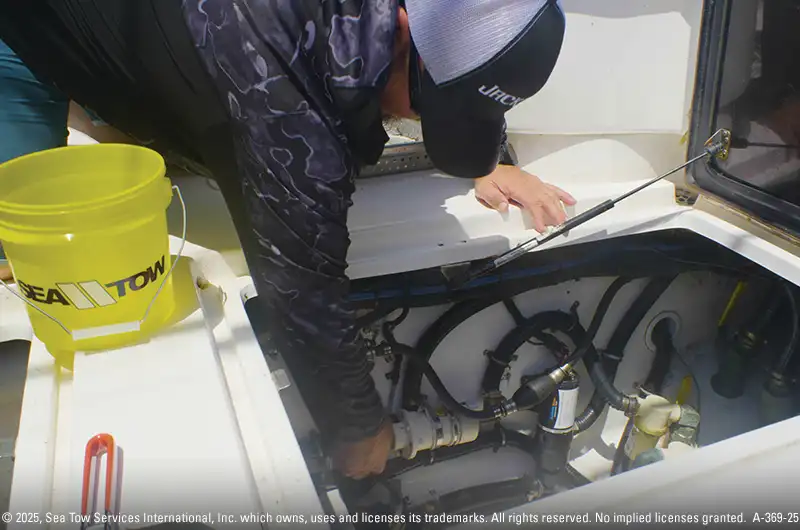
Your boat’s engine is its most critical component, and keeping it well-maintained ensures smooth operation, longevity, and reliability on the water. One of the easiest yet most essential maintenance tasks is checking the engine oil level regularly. Neglecting this simple step can lead to unnecessary wear, overheating, and even total failure, leaving you stranded and facing costly repairs.
Unlike cars, boat engines often operate under more demanding conditions – fluctuating RPMs, extended periods of idling, and exposure to moisture and salt. Because of this, marine engine oil needs more frequent attention than automotive oil. Knowing when and how to check your boat’s oil will help prevent problems before they start.
How Often Should You Check Your Boat’s Engine Oil?
Check boat oil before every trip. For occasional boaters (once or twice a month), check oil levels monthly and before trips. Frequent boaters (weekly use) should check oil every two weeks. Commercial vessels must check oil before and after trips. Change oil at least annually, as it degrades over time, even with low engine hours.
Marine engines rely on oil to lubricate moving parts, reduce friction, and dissipate heat. When oil levels drop too low, or if the oil becomes dirty and loses its lubricating properties, internal components can wear out prematurely, leading to significant mechanical issues.
In addition to preventing engine damage, monitoring oil levels helps maintain fuel efficiency and overall performance. Clean, high-quality oil keeps the engine running smoothly, reduces strain and prevents overheating. In turn, this means better fuel economy, more reliable starts, and fewer unexpected problems when you’re out on the water.
Failing to check your oil regularly could also lead to engine failure. If oil runs too low or becomes contaminated, internal parts can overheat and seize up, potentially causing irreversible damage. This kind of repair is not only expensive but could put your entire boating season on hold.
How to Check Your Boat’s Oil Level Correctly
A proper oil check takes only a few minutes but can prevent hours of frustration and costly repairs.
Park on a Level Surface
First, ensure your boat is on a level surface. An uneven boat can cause oil to pool on one side of the crankcase which would mean inaccurate reading.
Turn Off the Engine & Let It Cool
Next, allow the engine to cool down before checking the oil. While some boat owners prefer to check oil levels after running the engine, checking when the engine is cool provides a more stable reading.
Check the Dipstick
Locate the dipstick, which is usually near the engine’s oil reservoir. Pull it out, wipe it clean with a cloth, and then fully reinsert it. After pulling it out again, check the oil level against the markings on the dipstick. The oil should fall within the recommended range. If it’s low, top it off with the manufacturer-recommended oil, and be sure you do not overfill.
Check the Quality of Oil
Oil quality is just as important as the level. Oil is typically light brown or amber and transparent, if it appears dark, thick, or has a burnt smell, it’s time to be changed.
Any signs of a milky appearance could indicate water contamination and requires immediate attention. Similarly, metallic specks in the oil can indicate internal wear and should be assessed by a professional.
Signs That Indicate an Oil Change is Needed
While regular checks help maintain oil levels, knowing when to change the oil is equally as important.
Decreased Power
One of the first signs of degraded oil is a loss of engine performance. If your boat is running sluggishly, struggling to accelerate, or consuming more fuel than usual, old or dirty oil could be the culprit.
Excessive Smoke
Another warning sign is excessive smoke from the exhaust. If you notice more smoke than usual, particularly a blue or dark color, it may be a sign that the oil is burning within the engine.
Burnt Oil
Burnt oil smell is another red flag and indicator that the oil has lost its effectiveness and needs to be replaced.
Unusual Noises
Unusual engine noises, such as knocking or ticking, can also be a sign that oil levels are too low or that the oil is not providing adequate lubrication. If the oil is not properly protecting the engine’s moving parts, friction increases, leading to these audible warning signs.
Choosing the Right Oil for Your Boat’s Engine
Using the correct type of oil is just as important as keeping it at the right level. Marine engines require oil formulated to withstand the unique conditions they operate under, including exposure to moisture, higher RPMs, and extended running periods.
Always consult your boat’s owner’s manual to determine the best oil type for your specific engine. Using anything other than the recommended oil can lead to performance issues, increased wear, and even damage.
Stay on Top of Oil Maintenance
Regularly checking and maintaining your boat’s oil is one of the simplest ways to keep your engine in top condition. A well-oiled engine runs more efficiently, lasts longer, and reduces the risk of breakdowns when you’re out on the water.
Making oil checks part of your routine—before every trip and at regular intervals throughout the year—can save you from unexpected trouble. It’s a small effort that leads to significant peace of mind.
Of course, even with the best maintenance routine, issues can still arise.
That’s where Sea Tow® comes in. Whether you experience an unexpected breakdown, run out of fuel, or need a tow back to shore, Sea Tow is standing by to assist. With membership, you get 24/7 access to professional Captains who are ready to help when you need it most.
